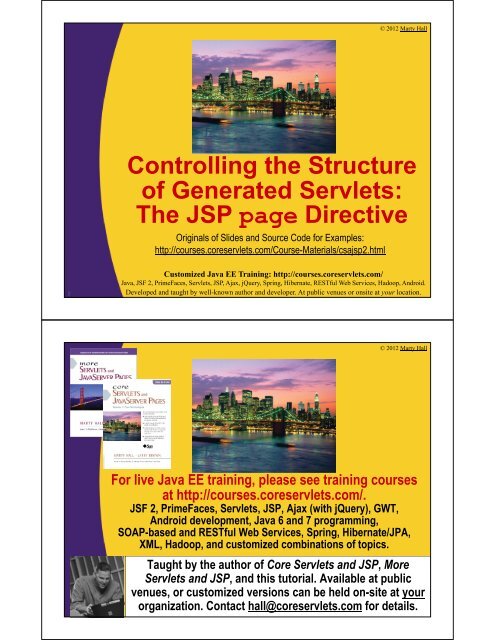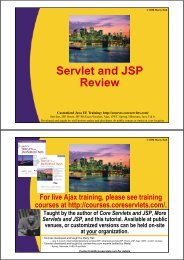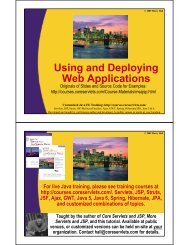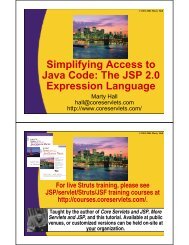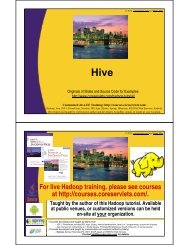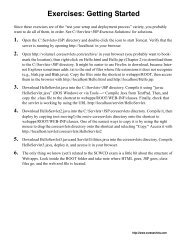Controlling the Structure of Generated Servlets: The JSP page ...
Controlling the Structure of Generated Servlets: The JSP page ...
Controlling the Structure of Generated Servlets: The JSP page ...
Create successful ePaper yourself
Turn your PDF publications into a flip-book with our unique Google optimized e-Paper software.
© 2012 Marty Hall<strong>Controlling</strong> <strong>the</strong> <strong>Structure</strong><strong>of</strong> <strong>Generated</strong> <strong>Servlets</strong>:<strong>The</strong> <strong>JSP</strong> <strong>page</strong> DirectiveOriginals <strong>of</strong> Slides and Source Code for Examples:http://courses.coreservlets.com/Course-Materials/csajsp2.html2Customized Java EE Training: http://courses.coreservlets.com/Java, JSF 2, PrimeFaces, <strong>Servlets</strong>, <strong>JSP</strong>, Ajax, jQuery, Spring, Hibernate, RESTful Web Services, Hadoop, Android.Developed and taught by well-known author and developer. At public venues or onsite at your location.© 2012 Marty HallFor live Java EE training, please see training coursesat http://courses.coreservlets.com/.JSF 2, PrimeFaces, <strong>Servlets</strong>, <strong>JSP</strong>, Ajax (with jQuery), GWT,Android development, Java 6 and 7 programming,SOAP-based and RESTful Web Services, Spring, Hibernate/JPA,XML, Hadoop, and customized combinations <strong>of</strong> topics.Taught by <strong>the</strong> author <strong>of</strong> Core <strong>Servlets</strong> and <strong>JSP</strong>, More<strong>Servlets</strong> and <strong>JSP</strong>, and this tutorial. Available at publicvenues, or customized versions can be held on-site at yourCustomized Java EE Training: http://courses.coreservlets.com/Java, JSF 2, PrimeFaces, <strong>Servlets</strong>, <strong>JSP</strong>, Ajax, jQuery, Spring, Hibernate, RESTful Web Services, Hadoop, Android.organization. Contact hall@coreservlets.com for details.Developed and taught by well-known author and developer. At public venues or onsite at your location.
Agenda• Understanding <strong>the</strong> purpose <strong>of</strong> <strong>the</strong> <strong>page</strong>directive• Designating which classes are imported• Specifying <strong>the</strong> MIME type <strong>of</strong> <strong>the</strong> <strong>page</strong>• Generating Excel spreadsheets• Participating in sessions• Setting <strong>the</strong> size and behavior <strong>of</strong> <strong>the</strong> outputbuffer• Designating <strong>page</strong>s to handle <strong>JSP</strong> errors• <strong>Controlling</strong> threading behavior4Purpose <strong>of</strong> <strong>the</strong> <strong>page</strong> Directive• Give high-level information about <strong>the</strong> servletthat will result from <strong>the</strong> <strong>JSP</strong> <strong>page</strong>• Can control– Which classes are imported– What class <strong>the</strong> servlet extends– What MIME type is generated– How multithreading is handled– If <strong>the</strong> servlet participates in sessions– <strong>The</strong> size and behavior <strong>of</strong> <strong>the</strong> output buffer– What <strong>page</strong> handles unexpected errors5
<strong>The</strong> import Attribute• Format– – • Purpose– Generate import statements at top <strong>of</strong> servlet definition• Notes– Although <strong>JSP</strong> <strong>page</strong>s can be almost anywhere on server,classes used by <strong>JSP</strong> <strong>page</strong>s must be in normal servlet dirs– E.g.:…/WEB-INF/classes or…/WEB-INF/classes/directoryMatchingPackage• Always use packages for utilities that will be used by <strong>JSP</strong>!6<strong>The</strong> Importance <strong>of</strong> UsingPackages• What package will <strong>the</strong> system think thatSomeHelperClass and SomeUtilityClass arein?...public class SomeClass {public String someMethod(...) {SomeHelperClass test = new SomeHelperClass(...);String someString =SomeUtilityClass.someStaticMethod(...);...}}7
<strong>The</strong> Importance <strong>of</strong> UsingPackages (Continued)• What package will <strong>the</strong> system think thatSomeHelperClass and SomeUtilityClass arein?...8<strong>The</strong> import Attribute: Example(Code)9…<strong>The</strong> import AttributeThis <strong>page</strong> was accessed on with a userIDcookie <strong>of</strong> .
<strong>The</strong> import Attribute: Example(Results)10<strong>The</strong> contentType and<strong>page</strong>Encoding Attributes• Format– – – • Purpose– Specify <strong>the</strong> MIME type <strong>of</strong> <strong>the</strong> <strong>page</strong> generated by <strong>the</strong>servlet that results from <strong>the</strong> <strong>JSP</strong> <strong>page</strong>• Notes– Attribute value cannot be computed at request time– See section on response headers for table <strong>of</strong> <strong>the</strong> mostcommon MIME types11
Generating Excel SpreadsheetsFirst Last Email AddressMarty Hall hall@coreservlets.comLarry Brown brown@coreservlets.comSteve Balmer balmer@ibm.comScott McNealy mcnealy@micros<strong>of</strong>t.com12Conditionally Generating ExcelSpreadsheets• You cannot use <strong>the</strong> contentType attributefor this task, since you cannot makecontentType be conditional.– <strong>The</strong> following always results in <strong>the</strong> Excel MIME type• Solution: use a regular <strong>JSP</strong> scriptlet withresponse.setContentType13
Conditionally Generating ExcelSpreadsheets (Code)…Comparing Apples and OrangesApplesOrangesFirst Quarter 2307 4706Second Quarter2982 5104Third Quarter 3011 5220Fourth Quarter3055 528714Conditionally Generating ExcelSpreadsheets (Results)15
<strong>The</strong> session Attribute• Format– – • Purpose– To designate that <strong>page</strong> not be part <strong>of</strong> a session• Notes– By default, it is part <strong>of</strong> a session– Saves memory on server if you have a high-traffic site– All related <strong>page</strong>s have to do this for it to be useful16<strong>The</strong> isELIgnored Attribute• Format– – • Purpose– To control whe<strong>the</strong>r <strong>the</strong> <strong>JSP</strong> 2.0 Expression Language(EL) is ignored (true) or evaluated normally (false).• Notes– If your web.xml specifies servlets 2.3 (corresponding to<strong>JSP</strong> 1.2) or earlier, <strong>the</strong> default is true• But it is still legal to change <strong>the</strong> default—you are permittedto use this attribute in a <strong>JSP</strong>-2.0-compliant serverregardless <strong>of</strong> <strong>the</strong> web.xml version.– If your web.xml specifies servlets 2.4 (corresponding to<strong>JSP</strong> 2.0) or earlier, <strong>the</strong> default is false17
<strong>The</strong> buffer Attribute• Format– – • Purpose– To give <strong>the</strong> size <strong>of</strong> <strong>the</strong> buffer used by <strong>the</strong> out variable• Notes– Buffering lets you set HTTP headers even after some<strong>page</strong> content has been generated (as long as buffer has notfilled up or been explicitly flushed)– Servers are allowed to use a larger size than you ask for,but not a smaller size– Default is system-specific, but must be at least 8kb18<strong>The</strong> errorPage Attribute• Format– • Purpose– Specifies a <strong>JSP</strong> <strong>page</strong> that should process any exceptionsthrown but not caught in <strong>the</strong> current <strong>page</strong>• Notes– <strong>The</strong> exception thrown will be automatically available to<strong>the</strong> designated error <strong>page</strong> by means <strong>of</strong> <strong>the</strong> "exception"variable– <strong>The</strong> web.xml file lets you specify application-wide error<strong>page</strong>s that apply whenever certain exceptions or certainHTTP status codes result.• <strong>The</strong> errorPage attribute is for <strong>page</strong>-specific error <strong>page</strong>s19
<strong>The</strong> isErrorPage Attribute20• Format– – • Purpose– Indicates whe<strong>the</strong>r or not <strong>the</strong> current <strong>page</strong> can act as <strong>the</strong>error <strong>page</strong> for ano<strong>the</strong>r <strong>JSP</strong> <strong>page</strong>• Notes– A new predefined variable called exception is created andaccessible from error <strong>page</strong>s– Use this for emergency backup only; explicitly handle asmany exceptions as possible• Don't forget to always check query data for missing ormalformed valuesError Pages: Example21…Computing SpeedDistance: furlongs.Time: fortnights.Speed: furlongs per fortnight.
Error Pages: Example(Continued)…Error Computing SpeedComputeSpeed.jsp reported <strong>the</strong> following error:. This problem occurred in <strong>the</strong>following place:22Error Pages: Results23
<strong>The</strong> extends Attribute• Format– • Purpose– To specify parent class <strong>of</strong> servlet thatwill result from <strong>JSP</strong> <strong>page</strong>• Notes– Use with extreme caution– Can prevent system from using high-performance customsuperclasses– Typical purpose is to let you extend classes that comefrom <strong>the</strong> server vendor (e.g., to support personalizationfeatures), not to extend your own classes.24<strong>The</strong> isThreadSafe Attribute• Format– – • Purpose– To tell <strong>the</strong> system when your code is not threadsafe, sothat <strong>the</strong> system can prevent concurrent access• Normally tells <strong>the</strong> servlet to implement SingleThreadModel• Notes– Avoid this like <strong>the</strong> plague• Causes degraded performance in some situations• Causes incorrect results in o<strong>the</strong>rs25
Example <strong>of</strong> Non-ThreadsafeCode (IDs Must Be Unique)• What's wrong with this code?26Is isThreadSafe Needed Here?27• No! It is not needed. Synchronize normally:• Better performance in high-trafficenvironments• isThreadSafe="false" will totally fail if serveruses pool-<strong>of</strong>-instances approach
Summary28• Used frequently– import• Changes <strong>the</strong> packages imported by <strong>the</strong> servlet that results from<strong>the</strong> <strong>JSP</strong> <strong>page</strong>– Always use packages for utility classes!– contentType• Specifies MIME type <strong>of</strong> result• Cannot be used conditionally(use for that)• Used moderately– isELIgnored, session, buffer• Used occasionally– errorPage/isError<strong>page</strong>– extends• Avoid like <strong>the</strong> plague– isThreadSafe• Always use explicit synchronization instead© 2012 Marty HallQuestions?JSF 2, PrimeFaces, Java 7, Ajax, jQuery, Hadoop, RESTful Web Services, Android, Spring, Hibernate, <strong>Servlets</strong>, <strong>JSP</strong>, GWT, and o<strong>the</strong>r Java EE training29Customized Java EE Training: http://courses.coreservlets.com/Java, JSF 2, PrimeFaces, <strong>Servlets</strong>, <strong>JSP</strong>, Ajax, jQuery, Spring, Hibernate, RESTful Web Services, Hadoop, Android.Developed and taught by well-known author and developer. At public venues or onsite at your location.


